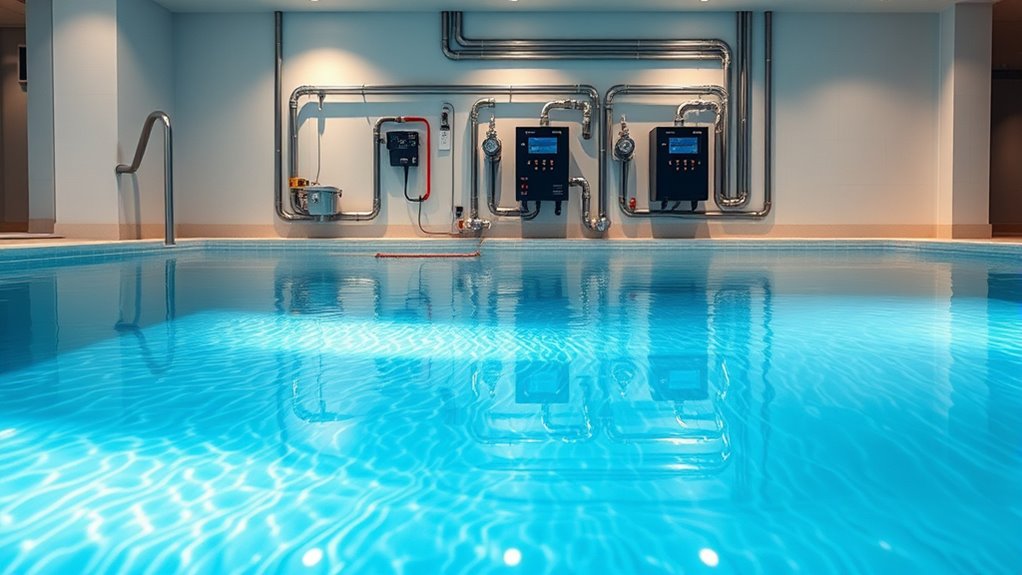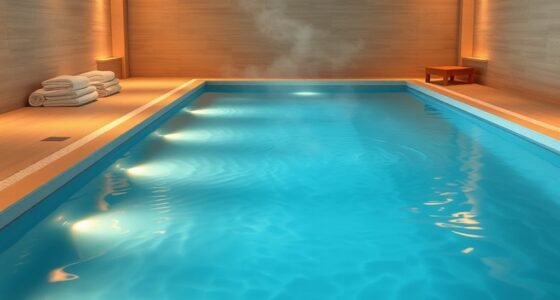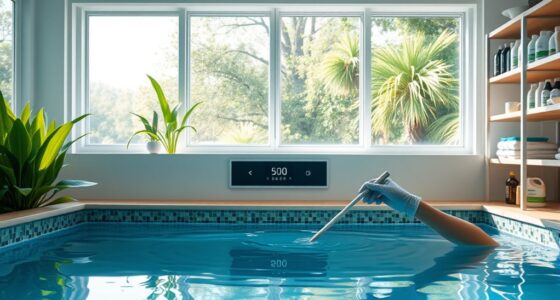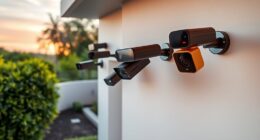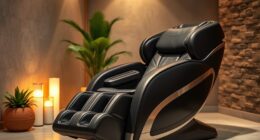To set up your endless pool, ensure you have a dedicated GFCI-protected circuit (220-240V) and properly sized pump—typically 1-2 HP for circulating water every 30 minutes—paired with a suitable filter. Plan your plumbing with durable materials like PVC, positioning inlet and outlet for ideal flow, and include valves for easy control. Regular maintenance of filters and checks on connections keep your water clean and safe. Continuing your exploration will reveal essential tips to perfect your setup.
Key Takeaways
- Use dedicated GFCI-protected circuits, typically 220-240V, for safe electrical power supply.
- Select the appropriate pump size based on pool volume, ensuring circulation at least once every 30 minutes.
- Plan plumbing with durable PVC or flexible hoses, minimizing pipe length and sharp bends for optimal flow.
- Install flow valves for easy water flow adjustments and shut-offs for maintenance access.
- Regularly inspect electrical wiring, connections, and plumbing components to ensure safety and efficiency.
Essential Water Circulation Components

To guarantee your Endless Pool stays clean and safe, the vital water circulation components must work efficiently. You need a reliable inlet and outlet system to keep the water moving smoothly. The inlet introduces fresh water and helps distribute chemicals evenly, while the outlet removes debris and stagnant water. Proper placement of these components ensures consistent circulation, preventing algae buildup and maintaining water clarity. Additionally, flow valves control the water movement, allowing you to adjust flow rates as needed. Without adequate circulation, your pool can develop unpleasant odors, bacteria, and algae. Regular inspection and maintenance of these components are essential to keep the water fresh, clean, and safe for every swim. Properly functioning circulation systems are the foundation of a healthy Endless Pool. Effective water circulation is especially crucial for avoiding issues related to stagnant water and maintaining a hygienic environment.
Pump and Filtration System Requirements
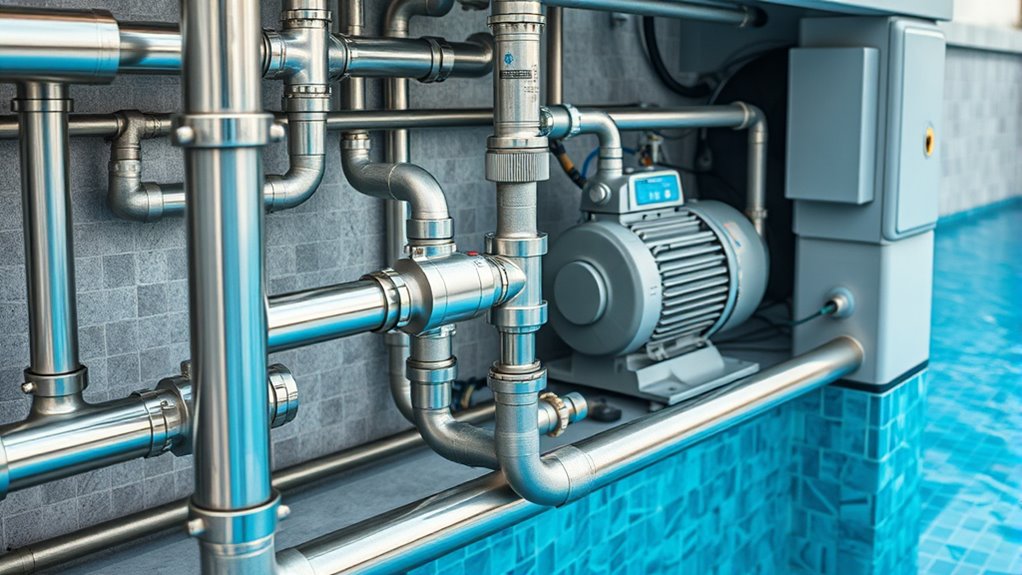
Selecting the right pump and filtration system is essential for maintaining clean, clear water in your Endless Pool. You need a pump that can circulate all the water at least once every 30 minutes to guarantee ideal clarity and hygiene. The filtration system should be powerful enough to trap debris, oils, and bacteria, keeping the water fresh. Consider the flow rate and filter type when choosing your setup. Here’s a quick guide:
| Pump Size | Filter Type | Maintenance Needed |
|---|---|---|
| 1-2 HP | Cartridge | Regular cleaning |
| 2-3 HP | Sand | Occasional backwash |
| 0.5-1 HP | Diatomaceous Earth | Infrequent replacement |
A proper system ensures your pool stays inviting and safe. Additionally, selecting a filter type that suits your usage frequency and water conditions will help maintain optimal water quality over time.
Plumbing Layout and Connections
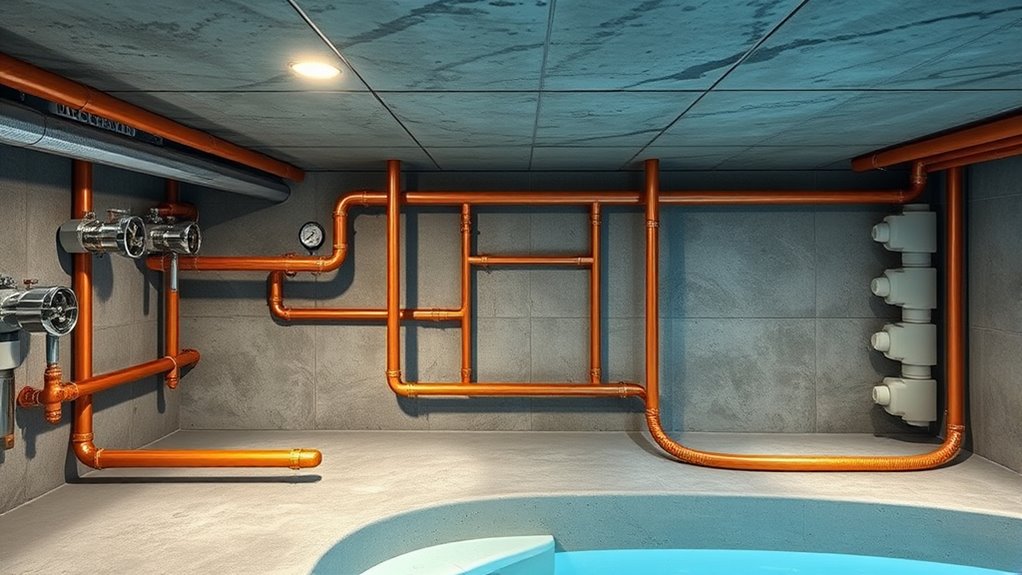
Establishing an efficient plumbing layout is essential for guaranteeing proper water flow and easy maintenance in your Endless Pool. Start by planning the placement of supply and return lines to minimize the length of pipes and reduce pressure loss. Use high-quality, durable materials like PVC or flexible hoses designed for water systems. Keep connections accessible for future servicing, and avoid sharp bends that can restrict flow. Ensure the inlet and outlet are positioned correctly to promote even water circulation. Also, incorporate valves for easy shut-off during maintenance or emergencies. Properly securing pipes prevents movement or damage over time. A well-designed layout not only optimizes water flow but also simplifies troubleshooting and routine upkeep, keeping your pool running smoothly and efficiently. Additionally, understanding sound vibrations can contribute to enhanced cellular regeneration and overall health, which may positively influence your pool environment and user experience.
Electrical Power Specifications and Safety Measures
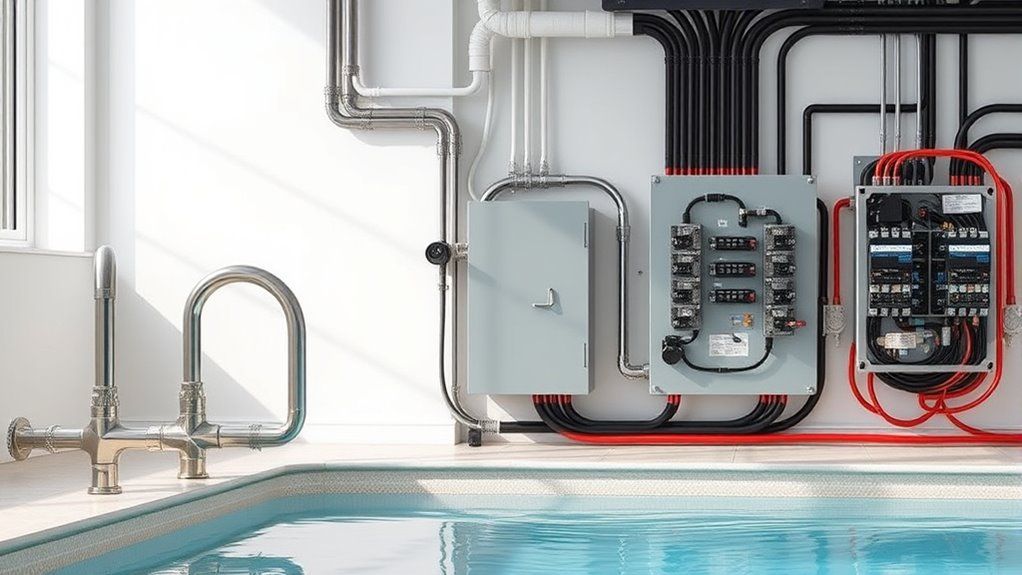
Ensuring your Endless Pool has the correct electrical power setup is crucial for safe and reliable operation. You need a dedicated GFCI-protected circuit, typically 220-240 volts, to handle the pool’s power demands. Check your manufacturer’s specifications to determine the exact amperage needed; oversizing can cause safety issues, while undersizing may lead to poor performance. Always install electrical components according to local codes and standards. Make sure all wiring is properly grounded, and avoid sharing circuits with other appliances. Use waterproof disconnect switches for added safety, and keep all electrical connections away from water sources. Regularly inspect cords and outlets for damage, and consider hiring a licensed electrician for installation to ensure everything is up to code and safely configured. Additionally, understanding electrical power specifications is essential to prevent potential hazards and ensure your pool runs efficiently.
Maintenance and Troubleshooting Tips
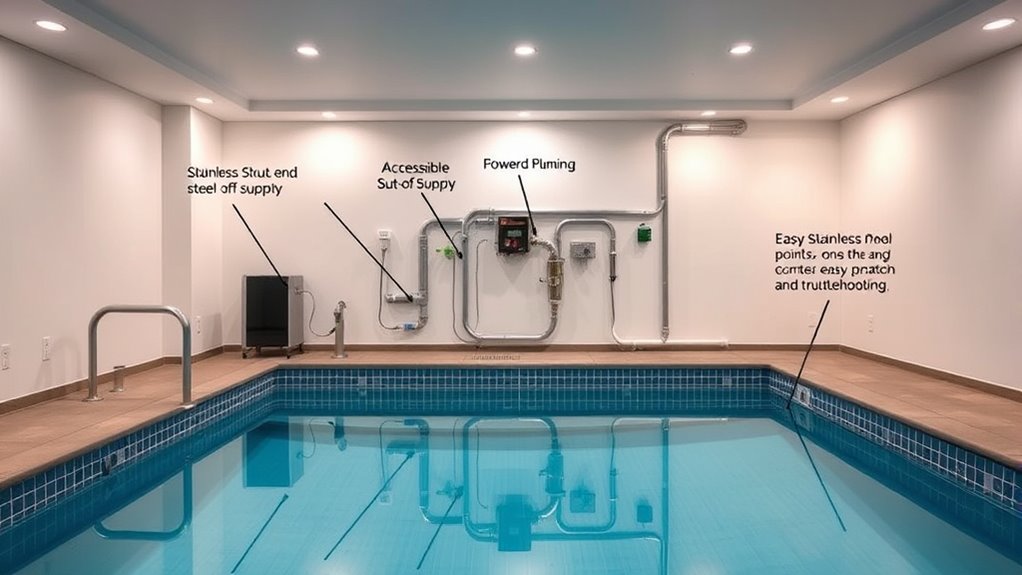
Regular maintenance is essential to keep your Endless Pool running smoothly and to prevent costly repairs. Check the filtration system weekly to ensure filters are clean and functioning properly. Regularly inspect hoses and connections for leaks or cracks, replacing any damaged parts immediately. Keep the water balanced by testing pH and sanitizer levels at least twice a week; proper chemical levels prevent algae and buildup. If you notice decreased water flow or unusual noises, troubleshoot by inspecting the pump and plumbing for obstructions or wear. Drain and clean the pool periodically to remove debris and scale. Always follow manufacturer guidelines for maintenance schedules and parts replacement. Proper water chemistry and filtration system maintenance are crucial for preventing bacterial growth and ensuring safe swimming conditions. Promptly address issues to extend your pool’s lifespan and enjoy uninterrupted use.
Frequently Asked Questions
Can I Install an Endless Pool Outdoors in Any Climate?
Yes, you can install an endless pool outdoors in many climates, but you should consider your local weather conditions. If you live in a colder area, you’ll need to guarantee proper insulation and a sturdy cover to protect it from freezing temperatures. In milder climates, outdoor installation is more straightforward, but regular maintenance is still essential to prevent damage from weather. Always check manufacturer guidelines for specific climate recommendations.
What Is the Typical Lifespan of the Plumbing and Electrical Components?
Your plumbing and electrical components can last a lifetime if you maintain them properly, but without care, they might fail in just a few years. Typically, expect the plumbing to last 10-15 years and electrical parts around 8-12 years. Regular inspections, cleaning, and prompt repairs extend their lifespan markedly. Neglecting maintenance could turn your endless pool into an endless headache, so stay vigilant and keep everything in top shape.
Are There Specific Permits Required for Installing Pool Plumbing and Electrical Systems?
Yes, you’ll likely need permits for installing pool plumbing and electrical systems. Check with your local building department, as requirements vary by location. You’ll probably need a permit for electrical work, especially if wiring or a new circuit is involved. Plumbing permits may also be required if you’re connecting to existing water lines or installing new drainage. Getting the proper permits guarantees safety and compliance, preventing future legal or safety issues.
How Do I Upgrade My Setup for Increased Water Flow or Features?
You can upgrade your setup by installing a higher-capacity pump to increase water flow and support additional features. Consider adding advanced filtration systems or jets for enhanced performance. Guarantee your electrical system can handle the increased load, possibly upgrading your circuit breaker. Consult a professional to verify compatibility and safety. Regularly check your plumbing connections for leaks or blockages to maintain peak flow and functionality.
Is Professional Installation Necessary, or Can I Do It Myself?
You can attempt a DIY installation if you’re comfortable with plumbing and electrical work, but professional installation is highly recommended. Experts ensure the setup meets safety standards, handles complex connections, and avoids costly mistakes. If you’re unsure about your skills, hiring a professional saves time, reduces risks, and guarantees your endless pool operates efficiently and safely. Ultimately, professional installation offers peace of mind and proper setup for peak performance.
Conclusion
So, after all that planning, you might think setting up your endless pool is a breeze. But don’t be fooled—proper plumbing and power are tricky, and ignoring details could turn your dream into a nightmare. Ironically, the most overlooked part might just be the one that keeps everything running smoothly. Stay vigilant, follow the guide, and you’ll avoid costly mishaps. After all, who knew that endless fun requires endless attention?
